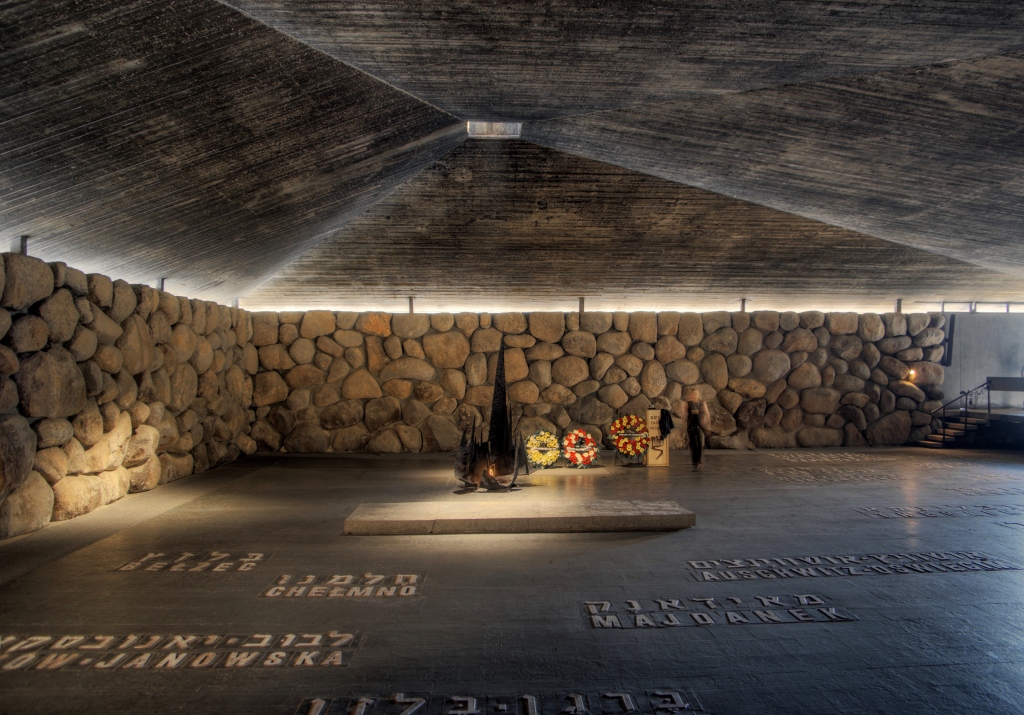Prof. Doron Bar’s latest article in JHR, The Hall of Remembrance at Yad Vashem: Israel’s Holocaust Commemoration Monument provides insight into the little-known history of the construction of one of the world’s first Holocaust memorials. Prof. Bar’s article, “describes years of complex deliberations among the leaders of Yad Vashem.” The article sheds light on the complexity of building memorial spaces, especially in the immediate aftermath of the Holocaust. It delves into the complicated relationship between the architects and historians of Yad Vashem, the particular architectural considerations, and the responsibility of building an effective memorial of national mourning.
In his article, Prof. Bar concludes that the Hall of Remembrance, “successfully reflects the connection between Israel and Europe, between the years of devastation and the years in which the institution was established, and between suffering and redemption… The leaders and architects of Yad Vashem succeeded in transforming the Mount of Remembrance and the Hall of Remembrance at its heart into the most prominent memorial site in the State of Israel.”

Prof. Bar, who is the President of the Schechter Institute of Jewish Studies in Jerusalem, took us behind the issue and answered some questions about this unique and thought-provoking article.
JHR- In the conclusion of your article, you refer to Ben-Zion Dinur’s speech at the 1956 convention for the design and image of the memorial mountain, in which he ‘talked about how difficult it was for memorial structures to reflect millions of actual Holocaust victims, as well as abstract inner strength, including “sanctification, courage, and love for one another in the hearts and spirits of the people, which shaped their identities during these horrific times.’” Yet, there is a conspicuous lack of survivors among the team who were in charge or involved with designing the Hall of Remembrance. How do you account for this apparent discrepancy?
DB- You are right. The five architects were part of the generation of “HALUTZIM,” pioneers. Although they were all born outside Israel – they wanted to be seen and regarded as locals and not as people coming from “there.” Their architecture was a mixture of international and local design. It seems to me that the heads of Yad Vashem wanted the architecture of the site to be detached from the diaspora and saw the “GOLA” (diaspora) negatively. Further – out of Yad Vashem’s body of workers and researchers, as far as I know – there were some holocaust survivors but in small numbers. There was always a tension between them (the survivors) and the people who managed the institute.
JHR- There is repeated reference to the Hall of Remembrance producing feelings of shock, awe, intensity and profundity. Over 60 years on, do you believe that the Hall of Remembrance still possess such qualities? In other words, architecturally speaking, has it stood the test of time?
DB- Sadly, it seems to me that the answer is no. I think that the change happened after 2005 when the “new” Yad Vashem was presented to the public. If until then, most of the attention was given to the museum and to the Hall, today it seems to me that most of the groups are not visiting it. All the groups will go to the museum. It seems to me that something about the proportions of the site of Yad Vashem, in general, were lost. Despite what I wrote in this article, I think those who do bother to enter the Hall, do feel even today, how unique and special the memorial is. It still forces the visitor to contemplate and to think deeply (and independently) about the Holocaust.

JHR- Contemporary trends within Israel show that Orthodox communities are disproportionately underrepresented in Yad Vashem’s visitor numbers. Might this be rooted in the early disputes between the religious community and the memorial’s founders regarding the burial of ashes?
Indeed. I have a different article about the issue of building a synagogue inside Yad Vashem. This question – the place of Judaism and tradition in Yad Vashem- was raised as early as the 1940. The Orthodox always felt detached from it. Some of them saw MARTEF HASHO’A (Chamber of the Holocaust – erected in 1949) in Mount Zion as a substitute. It seems that the issue of orthodox not visiting the site is much deeper than the issue of ashes but it is connected to the fact that Yad Vashem was seen by them as national-Zionist-Israeli site, not connected to Jewish tradition.
*Correction: The original publication incorrectly wrote that Martef Hashoa is located on Mount Herzl, rather than Mount Zion.
Read Miranda Brethour’s full article in the latest issue of The Journal of Holocaust Research.
Thanks for the interesting interview, to my knowledge Martef HaShoah is on Mount Zion not Mount Herzl as stated in the last answer by Prof. Bar. Yad Vashem is on Mt.Herzl so maybe there was a confusion.
LikeLike